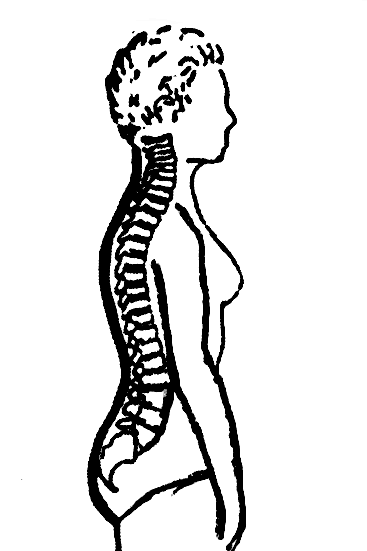We recently asked Nancy Schommer, our medical correspondent, to
interview Dr. Martin Wolpin, an orthopedic surgeon who specializes
in spinal deformities. Dr. Wolpin is chief of the scoliosis service
of Maimonides Medical Center, Brooklyn, New York.
Q: Dr Wolpin, how would you characterize the spinal condition
known as lordosis, which is sometimes referred to as a swayback?
A: Let me begin by giving you some background information. If you
look at a side view of a person, you will see that the normal spine
has two areas that are lordotic, or curved slightly forward, as
in a reverse C. Normally, we all have a certain amount of cervical
(neck) lordosis, and lumbar (lower back) lordosis. In the thoracic
(chest) we usually have a backward curve or kyphosis. In fact, we
want a little lordosis in the neck and lower back because it gives
us a good mechanical advantage and a functional position with which
to maintain an erect posture.
 (click image to enlarge)
(click image to enlarge)
Q: Is there a "proper" amount of lordosis in these
areas that one should have?
A: The degree of proper lordosis is extremely variable; in the lower
back, for example, a lordosis can be as much as 20 to 50 degrees.
But I want to stress to your readers that in the majority of cases,
lordosis is more of a cosmetic alignment problem and not really
a significant functional alignment problem in itself. In fact, rarely
do we do anything to treat lordosis, per se, unless there is an
underlying condition that is causing an increased lordosis.
Q: What is an example of an underlying condition that can cause
an increased lordosis?
A: We're usually dealing with a problem of some significance below
the level of the lordosis. For example, a deformity such as spondylolisthesis.
In such cases, the lower segment of the spine demonstrates a kyphotic
angulation and the lordosis is increased to compensate for that
element of kyphosis. Other pathological problems are usually due
to underlying neuromuscular conditions.
Q: How would you treat that patient medically?
A: Patients with spondylolisthesis often have tight hamstrings and
the body is compensating for that. Thus, we'd probably recommend
stretching exercises, such as pelvic tilts, to improve muscle tone
and lower the increase of lordosis, or use temporary bracing together
with exercise. In many cases, however, we would surgically repair
the spondylolisthesis, and that would tend to correct the lordosis.
Remember, in these cases, we're not doing surgery to correct the
lordosis. We're doing surgery to correct the underlying, more serious
problem.
Q: We've heard that loss of lordosis can be a problem. What
would cause that?
A: Patients do have problems when they lose their lordosis. As they
get older, some patients experience degeneration of the disks and
the face joints. These degenerative changes cause them to lose their
lordosis of the lower back. We've also found that some scoliosis
patients who've had Harrington rods implanted along the lower spine
can experience a loss of lordosis. In both these cases, the person
has the appearance of a flat back, and as a result can experience
pain.
Q: With respect to the flatback that may be caused by Harrington
rods, what can done?
A: Although some of these conditions can be repaired surgically,
doctors are attempting to avoid the problem in the first place by
using one of the new rotational surgical items to treat scoliosis:
the CD for example, or the Scottish Rite system. Both of these allow
you to build an element of lumbar lordosis while straightening the
spine.
Q: From everything you've said, it sounds like lordosis isn't
that much of a problem, but that an underlying condition causing
the lordosis could be a problem and may need to be treated.
A: That's true. When we see a patient who presents with a lordosis,
the first question is: Is the patient clinically symptomatic? In
other words, is there a problem of pain or limitation of function?
Then we evaluate the person to see whether a structural deformity
within the vertebral lies or disk spaces is causing the lordosis.
We would also check to see ether there is an underlying neuromuscular
problem, such as muscular dystrophy, that is causing a muscle imbalance.
Q: And what do you do if there are no underlying problems?
A: If you rule out all those problems we would not consider the
lordosis to be of clinical significance. For most people with an
exaggerated lordosis not caused by any underlying dysfunction, posture
strengthening exercises would help diminish this cosmetic condition.
Back to Medical Updates